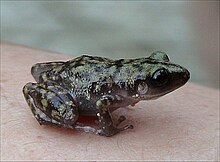Eleutherodactylus marnockii, the cliff chirping frog, is a small eleutherodactylid frog found in Central and West Texas, United States,[1][2][3] and in Coahuila and Chihuahua, northern Mexico.[1] It is also known as the cliff frog and Marnock's frog.[2]
| Eleutherodactylus marnockii | |
|---|---|

| |
| Scientific classification | |
| Domain: | Eukaryota |
| Kingdom: | Animalia |
| Phylum: | Chordata |
| Class: | Amphibia |
| Order: | Anura |
| Family: | Eleutherodactylidae |
| Genus: | Eleutherodactylus |
| Subgenus: | Syrrhophus |
| Species: | E. marnockii
|
| Binomial name | |
| Eleutherodactylus marnockii (Cope, 1878)
| |
| Synonyms[2] | |
|
Syrrhophus marnockii Cope, 1878 | |
Taxonomy edit
Synonymy of Eleutherodactylus guttilatus with this species has been proposed but is not accepted by all authors.[4] Intermediates between the two species have been reported from Nuevo León in northern Mexico.[4] Some subpopulations of E. guttilatus from Big Bend, Texas, northern Coahuila and Chihuahua are treated as E. marnockii by the International Union for Conservation of Nature.[1]
Description edit
Adult cliff frogs are 19–38 mm (0.75–1.5 in) in length. They have greenish ground color with brown mottling, often with banding on the rear legs. They have somewhat flattened bodies which allow them to hide in rock crevices.[5]
Behavior and habitat edit
Cliff chirping frogs are nocturnal and live most of their lives on limestone rock faces.[1][5] They may also be found in caves, pinion forests, juniper forests, scrub, grassland, suburban areas and city parks.[1] Like most frogs, they will hop, but they are also capable of crawling, which aids them in hiding in rock crevices.[5]
Reproduction edit
Breeding occurs year-round, except at the coldest times of the winter, but generally peaks during the rainy season in April and May. Females can lay up to three clutches of eggs a year, in a moist substrate of leaf litter or soil.[5]
References edit
- ^ a b c d e f IUCN SSC Amphibian Specialist Group (2022). "Eleutherodactylus marnockii". IUCN Red List of Threatened Species. 2022: e.T56744A53965348. doi:10.2305/IUCN.UK.2022-1.RLTS.T56744A53965348.en. Retrieved 27 March 2024.
- ^ a b c Frost, Darrel R. (2024). "Eleutherodactylus marnockii (Cope, 1878)". Amphibian Species of the World: an Online Reference. Version 6.2. American Museum of Natural History. Retrieved 27 March 2024.
- ^ Bassett, Lawrence G. (2023). "Updated Geographic Distributions for Texas Amphibians". Reptiles & Amphibians. 30 (1). doi:10.17161/randa.v30i1.18486. S2CID 258043781. e18486.
- ^ a b Frost, Darrel R. (2024). "Eleutherodactylus guttilatus (Cope, 1879)". Amphibian Species of the World: an Online Reference. Version 6.2. American Museum of Natural History. Retrieved 27 March 2024.
- ^ a b c d "Cliff Chirping Frog". Herps of Texas. Retrieved 4 May 2017.
